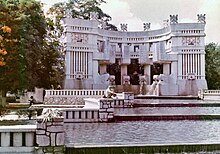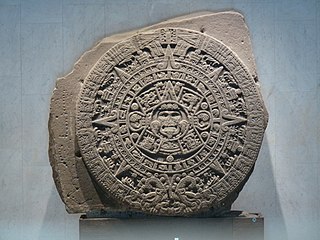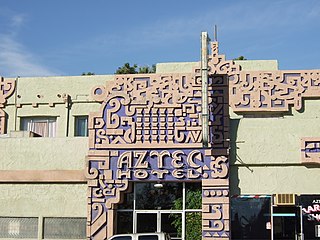
Maya Revival is a modern architectural style popular in the Americas during the 1920s and 1930s [1] that drew inspiration from the architecture and iconography of pre-Columbian Mesoamerican cultures.

Maya Revival is a modern architectural style popular in the Americas during the 1920s and 1930s [1] that drew inspiration from the architecture and iconography of pre-Columbian Mesoamerican cultures.


Though the name of the style refers specifically to the Maya civilization of southern Mexico and Central America, in practice, this revivalist style frequently blends Maya architectural and artistic motifs "playful pilferings of the architectural and decorative elements" [2] with those of other Mesoamerican cultures, particularly the Central Mexican Aztec architecture styling from the pre-contact period as exhibited by the Mexica and other Nahua groups. Although there were mutual influences between these original and otherwise distinct and richly varied pre-Columbian artistic traditions, the syncretism of these modern reproductions is often an ahistorical one.
Historian Marjorie Ingle traces the history of this style to the Pan American Union Building by Paul Philippe Cret which incorporates numerous motifs drawn from the indigenous traditions of the Americas. [3] Maya and Mexica elements in the Pan American Union Building include the floor mosaics surrounding a central fountain (most of the motifs are copied directly from sculpture at Copan) and figures on lights flanking the entrance to the building. The building's Art Museum of the Americas contains numerous stoneware architectural details that are copied from Maya and Mexica art.

Several prominent architects worked in this style, including Frank Lloyd Wright. Wright's Hollyhock House on Olive Hill in Los Angeles copied the shape of temples from Palenque, and the Imperial Hotel in Tokyo was in the shape of a Mesoamerican pyramid. His Ennis House, Millard House (La Miniatura), Storer House, and Freeman House in Los Angeles are built in his concrete textile block system, with bas reliefs and modular unit construction evoking the geometric patterning on the façades of Uxmal buildings.

Wright's son, landscape architect and architect Lloyd Wright, served as construction manager for three of his father's four textile block houses. He independently designed the Henry Bollman house in 1922 in the Sunset Square neighborhood in Hollywood and the iconic Mayan-modernist John Sowden House in 1926 in the Los Feliz District of Hollywood.
Wright's disciple Arata Endo constructed the Kōshien Hotel in the 1930s, heavily influenced by the architecture of the Imperial Hotel in Tokyo.
Commissioned in 1953, the massive pyramid of the Beth Sholom Synagogue with its geometric roof detailing is perhaps the most direct Wright evocation of Maya form.
Likely the most publicized example of Mayan Revival was Robert Stacy-Judd's Aztec Hotel of 1924–1925. Its façade, interiors and furniture incorporated abstract patterns inspired by the Maya script with Art Deco influences, and it was built on the original U.S. Route 66 in Monrovia, California.
Stacy-Judd was directly influenced by John Lloyd Stephens writings, and perhaps even more so by the illustrations by Frederick Catherwood as presented in their book Incidents of Travel in Central America, Chiapas and Yucatan, [4] a work that introduced many to the wondrous ruins of Central America. In it Stacy-Judd explains the choice of the name of the hotel: "When the hotel project was first announced, the word Maya was unknown to the layman. The subject of Maya culture was only of archaeological importance, a, at that, concerned but a few exponents. As a word Aztec was fairly well known, I baptized the hotel with that name, although all the decorative motifs are Maya." [5] Although the buildings use of reinforced concrete to create the intricate designs on the exterior one opinionated observer wrote: "The bizarre Aztec forms may create the atmosphere desired, and will serve the legitimate publicity interests of the establishment, but it would be deplorable if an 'Aztec Movement' set in and the style copyists were diverted from noble examples to the forms of a semi-barbaric people." [6]
Other prominent buildings in this style include:

Mesoamerican chronology divides the history of prehispanic Mesoamerica into several periods: the Paleo-Indian ; the Archaic, the Preclassic or Formative (2500 BCE – 250 CE), the Classic (250–900 CE), and the Postclassic (900–1521 CE); as well as the post European contact Colonial Period (1521–1821), and Postcolonial, or the period after independence from Spain (1821–present).

Miguel León-Portilla was a Mexican anthropologist and historian, specializing in Aztec culture and literature of the pre-Columbian and colonial eras. Many of his works were translated to English and he was a well-recognized scholar internationally. In 2013, the Library of Congress of the United States bestowed on him the Living Legend Award.
Gender roles existed in Mesoamerica, with a sexual division of labour meaning that women took on many domestic tasks including child-rearing and food preparation while only men were typically allowed to use weapons and assume positions of leadership. Both men and women farmed, but in some societies, women were not permitted to plough the fields because it was believed to symbolise men's role in the reproductive cycle.

Mesoamerican pyramids form a prominent part of ancient Mesoamerican architecture. Although similar in some ways to Egyptian pyramids, these New World structures have flat tops and stairs ascending their faces. The largest pyramid in the world by volume is the Great Pyramid of Cholula, in the east-central Mexican state of Puebla. The builders of certain classic Mesoamerican pyramids have decorated them copiously with stories about the Hero Twins, the feathered serpent Quetzalcoatl, Mesoamerican creation myths, ritualistic sacrifice, etc. written in the form of Maya script on the rises of the steps of the pyramids, on the walls, and on the sculptures contained within.

Pre-Columbian art refers to the visual arts of indigenous peoples of the Caribbean, North, Central, and South Americas from at least 13,000 BCE to the European conquests starting in the late 15th and early 16th centuries. The Pre-Columbian era continued for a time after these in many places, or had a transitional phase afterwards. Many types of perishable artifacts that were once very common, such as woven textiles, typically have not been preserved, but Precolumbian monumental sculpture, metalwork in gold, pottery, and painting on ceramics, walls, and rocks have survived more frequently.
The Mayan architecture of the Maya civilization spans across several thousands of years, several eras of political change, and architectural innovation before the Spanish colonization of the Americas. Often, the buildings most dramatic and easily recognizable as creations of the Maya peoples are the step pyramids of the Terminal Preclassic Maya period and beyond. Based in general Mesoamerican architectural traditions, the Maya utilized geometric proportions and intricate carving to build everything from simple houses to ornate temples. This article focuses on the more well-known pre-classic and classic examples of Maya architecture. The temples like the ones at Palenque, Tikal, and Uxmal represent a zenith of Maya art and architecture. Through the observation of numerous elements and stylistic distinctions, remnants of Maya architecture have become an important key to understanding their religious beliefs and culture as a whole.

Mesoamerica is a historical region and cultural area that begins in the southern part of North America and extends to the Pacific coast of Central America, thus comprising the lands of central and southern Mexico, all of Belize, Guatemala, El Salvador, and small parts of Honduras, Nicaragua and Costa Rica. As a cultural area, Mesoamerica is defined by a mosaic of cultural traits developed and shared by its indigenous cultures.
Mesoamerica, along with Mesopotamia and China, is one of three known places in the world where writing is thought to have developed independently. Mesoamerican scripts deciphered to date are a combination of logographic and syllabic systems. They are often called hieroglyphs due to the iconic shapes of many of the glyphs, a pattern superficially similar to Egyptian hieroglyphs. Fifteen distinct writing systems have been identified in pre-Columbian Mesoamerica, many from a single inscription. The limits of archaeological dating methods make it difficult to establish which was the earliest and hence the progenitor from which the others developed. The best documented and deciphered Mesoamerican writing system, and the most widely known, is the classic Maya script. Earlier scripts with poorer and varying levels of decipherment include the Olmec hieroglyphs, the Zapotec script, and the Isthmian script, all of which date back to the 1st millennium BC. An extensive Mesoamerican literature has been conserved, partly in indigenous scripts and partly in postconquest transcriptions in the Latin script.

The traditions of indigenous Mesoamerican literature extend back to the oldest-attested forms of early writing in the Mesoamerican region, which date from around the mid-1st millennium BCE. Many of the pre-Columbian cultures of Mesoamerica are known to have been literate societies, who produced a number of Mesoamerican writing systems of varying degrees of complexity and completeness. Mesoamerican writing systems arose independently from other writing systems in the world, and their development represents one of the very few such origins in the history of writing.

Mesoamerican architecture is the set of architectural traditions produced by pre-Columbian cultures and civilizations of Mesoamerica, traditions which are best known in the form of public, ceremonial and urban monumental buildings and structures. The distinctive features of Mesoamerican architecture encompass a number of different regional and historical styles, which however are significantly interrelated. These styles developed throughout the different phases of Mesoamerican history as a result of the intensive cultural exchange between the different cultures of the Mesoamerican culture area through thousands of years. Mesoamerican architecture is mostly noted for its pyramids, which are the largest such structures outside of Ancient Egypt.

Robert Stacy-Judd (1884–1975) was an English architect and author who designed theaters, hotels, and other commercial buildings in the Mayan Revival architecture Style in Great Britain and the United States. Stacy-Judd's synthesis of the style used Maya architecture, Aztec architecture, and Art Deco precedents as his influences.

The Feathered Serpent is a prominent supernatural entity or deity, found in many Mesoamerican religions. It is still called Quetzalcoatl among the Aztecs, Kukulkan among the Yucatec Maya, and Q'uq'umatz and Tohil among the K'iche' Maya.
David S. Gebhard was a leading architectural historian, particularly known for his books on the architecture and architects of California. He was a long-time faculty member at the University of California, Santa Barbara, and was dedicated to the preservation of Santa Barbara architecture. Gebhard was also known for his archaeological work recording and documenting the multiple styles of pictographs in the Lower Pecos Canyonlands on the border of Texas and Mexico.

The pre-Columbian history of the territory now making up the country of Mexico is known through the work of archaeologists and epigraphers, and through the accounts of Spanish conquistadores, settlers and clergymen as well as the indigenous chroniclers of the immediate post-conquest period.

The Aztec Hotel is a historical landmark building in Monrovia, in the San Gabriel Valley, California. The hotel is an example of Mayan Revival architecture still in existence. It was designed by architect Robert Stacy-Judd, and built on U.S. Route 66 in 1925-26. The hotel opened to the public in September 1925, and contained over 40 rooms.
Francisco Cornejo was a Mexican painter and sculptor, specialized in Maya and Aztec themes. He was influenced by Pre-Columbian art.
In the United States, the National Register of Historic Places classifies its listings by various types of architecture. Listed properties often are given one or more of 40 standard architectural style classifications that appear in the National Register Information System (NRIS) database. Other properties are given a custom architectural description with "vernacular" or other qualifiers, and others have no style classification. Many National Register-listed properties do not fit into the several categories listed here, or they fit into more specialized subcategories.

The Atlantean figures are four anthropomorphic statues belonging to the Toltec culture in pre-Columbian Mesoamerica. These figures are "massive statues of Toltec warriors". They take their post-Columbian name from the European tradition of similar Atlas or Atalante figures in classical architecture.

First Baptist Church of Ventura is a historic church at 101 S. Laurel Street in Ventura, California. It was built in 1926 and renovated extensively into the Mayan Revival style in 1932. Declared a landmark by the City of Ventura In 1975, the building was added to the National Register of Historic Places in 2009. Since 1952, it has been home to the Ventura Center for Spiritual Living.